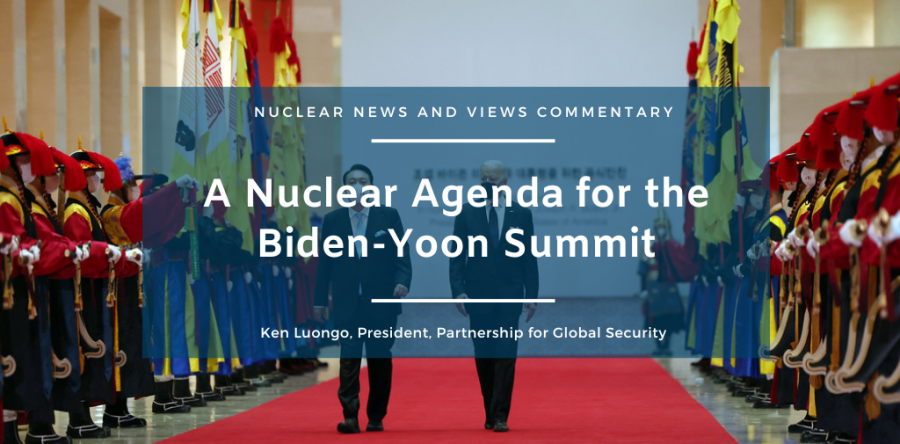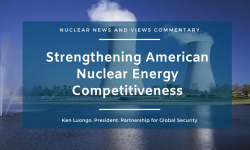The red carpet is being rolled out in Washington for the second U.S.-South Korea summit between Presidents Biden and Yoon. It will be held in late April and include a rare state dinner. This pomp reflects the growing importance of South Korea and its role as an essential ally in a region that is increasingly the centerpiece of U.S. global policy.
A major agenda item at the summit will be the overall nuclear relationship between the two countries. The North Korean nuclear and missile program inevitably will dominate the discussion as it is a rising danger that has numerous radiating impacts.
However, both nations would be wise to launch a detailed discussion on how to strengthen their deteriorated commercial nuclear relationship, which is a less publicized source of current bilateral conflict, and which holds promise for bolstering the two nation’s geopolitical alignment if it can be repaired.
The newly published Annual Threat Assessment of the U.S. Intelligence Community states that, North Korean leader, Kim Jong Un, “almost certainly views nuclear weapons and ICBMs as the ultimate guarantor of his autocratic rule and has no intention of abandoning those programs.”
That assessment severely limits the diplomatic maneuvering room for any potential deal with the DPRK to limit its arsenal. Denuclearization seems a distant dream under the current circumstances. And this pessimistic situation has exacerbated bilateral tensions.
It has intensified the latent interest in South Korea for acquiring its own nuclear weapons. In January, Yoon stated that if the situation on the Korean peninsula became more dangerous, “we could acquire our own nuclear weapons.” That assertion was quickly qualified with additional comments from the president’s office noting the country’s commitment to the Nuclear Non-Proliferation Treaty, which creates a barrier to nuclear weapons development. But the idea of an independent South Korean nuclear arsenal has public support.
The intensifying tension on the peninsula also has raised concerns about the strength of the U.S. guarantee to protect South Korea, including with the use of nuclear weapons, in response to an attack from the North. It relatedly has ratcheted calls for the redeployment of U.S. tactical nuclear weapons to South Korea, which were removed in the early 1990s.
In an effort to shore-up the extended deterrence commitment and beat back the enthusiasm for nuclear weapons based in South Korea, both nations have made a more visible display of their joint capabilities and announced the largest military exercises in the past five years.
It is certain that Biden and Yoon will not solve the North Korean nuclear challenge when they meet. But they do have the opportunity to make progress on other essential nuclear issues.
A critical area is to re-establish deep mutual trust in the commercial nuclear relationship.
The last several years have witnessed a freeze in U.S.-Korean civil nuclear cooperation because of a dispute between commercial nuclear giants, Westinghouse and KEPCO, over intellectual property in the Korean APR-1400 reactor and its relation to U.S. export controls.
This issue needs to be resolved expeditiously, and preferably before the April summit. It is the key to reconfiguring the commercial nuclear partnership on a more equal basis. But the wounds that have been created by the deep disagreement have left scars.
Competition between the nuclear industries of both countries for a share of the global nuclear market will be an area of continuing contention and it must be better managed. As nuclear energy becomes a viable option for decoupling Europe from Russian fossil fuels, a source of energy security for other nations, and a recognized zero-carbon energy source, the international market for nuclear technology will expand.
There needs to be a new understanding between the U.S. and South Korea on how to manage this competition without it once again boiling over and scalding an essential partnership.
Both nations have mutually dependent supply chains for their large-scale reactors. So, either nation will gain financially if the other wins a reactor tender. But both could suffer if mutual antagonism weakens their bond and opens reactor export opportunities for Russia or China.
There also is a danger that as a result of the intellectual property rift, South Korea will begin to drift away from partnership with the U.S. on next-generation small modular and advanced reactors. Right now, the U.S. is leading that technology race, but it is dependent on Korean financial and supply chain support. And South Korea is edging closer to the United Arab Emirates as a financing partner for nuclear technology development and export.
If South Korea were to make a concerted effort to strengthen its position in the small reactor market, it could seek to design its technology in a way that avoids U.S. export controls. That could create a security gap between the two nations in evaluating whether countries are fully prepared for nuclear power, including their willingness to accept high levels of nuclear security and a full range of safeguards. The Westinghouse-KEPCO fight was started over a very similar issue related to Saudi Arabia. This situation can’t be replicated.
Despite the challenges, and assuming the Westinghouse-KEPCO issue is settled before the summit, there are five other areas where the U.S. and South Korea could cooperate and potentially announce new initiatives at the summit.
Both countries need to jointly assess the strengths and weaknesses in their nuclear partnership in order to rebalance their cooperation and competition in the international nuclear market. A fundamental reality is that South Korea is no longer a junior commercial nuclear partner. Therefore, this discussion should focus on export opportunities, assess supply chain issues, and identify the strengths and weaknesses of each country and include commercial as well as government officials.
In addition, there needs to be engagement that builds a clear understanding of the joint commitment to require the nuclear safeguards Additional Protocol as a condition of supply in third countries. The agreement to do this has been codified in two bilateral summit statements, which are political commitments, but are not legally binding. Defining the parameters and implementation mechanisms of this commitment can alleviate potential political and commercial conflicts, as occurred with Saudi Arabia.
Also, the High-Level Bilateral Commission (HLBC), created by the 2015 U.S.-Korea nuclear cooperation agreement, should be revived but evolve to meet present day concerns. This forum was designed to address challenging issues at a high level. But the results to date have been disappointing. One critical issue to address is the actions necessary to dethrone Russia as the dominant global nuclear reactor and fuel exporter and prevent China from replacing it. This may require a range of cooperation including technology partnerships, developing fuel products that can replace Russian offerings, and creating advanced reactor test facilities that now only exist in Russia.
Further, the two nations should join forces on the development of the nuclear security and safeguards guidelines that will be required for small and advanced reactors that use exotic fuel cycles. It already is clear that some reactor designs, including those using molten salt and TRISO fuel, will not fit well within the current safeguards parameters of the IAEA. Those rules were designed primarily for large reactors where every fuel element can be counted. There also are novel nuclear security aspects of this next generation of reactors that need attention.
Finally, the two nations could take a page from the recent French initiative to build an alliance of EU states that advocate for nuclear energy as a climate change and energy security response. This idea could be expanded globally with the joint support of the U.S. and South Korea. An expanded concept could link the EU nations and others including Canada, the U.K., Japan, and India in a global nuclear alliance supporting zero-carbon power, energy security, and strong nuclear governance.
The Biden-Yoon summit is an important pivot point for U.S.-South Korea nuclear relations. The inability to halt the DPRK nuclear and missile program is a major challenge that is creating new tensions. But there also is corrosion in the relationship resulting from the deterioration of what was once a sterling civil nuclear partnership. Reestablishing the strength of this civil nuclear alliance is essential for addressing climate change, building energy security, upholding high nuclear governance standards, and preventing authoritarian nations from dominating global nuclear trade in this century. This is a large and important agenda with serious implications.
Ken Luongo, President, Partnership for Global Security




